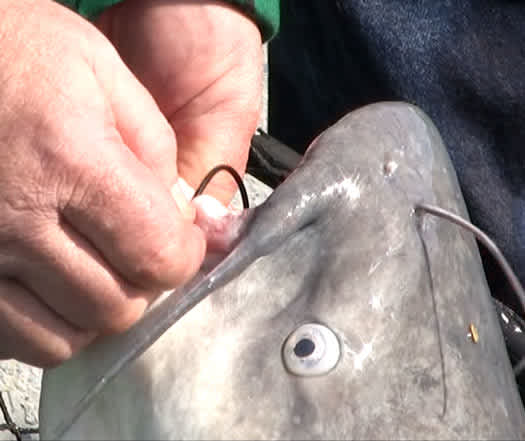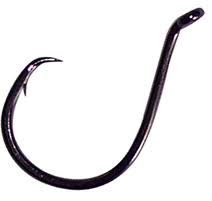The Perfect Circle: Circle Hooks for Catfishing
Steve Douglas 02.20.12

Circle hooks are becoming increasingly popular in the world of catfishing but their usage is still widely misunderstood. When you look at a circle hook, your first thought may be “how’s that going to hook a catfish?” The sharp tip is pointed backwards towards the shank and the gap of the hook (distance between the point and the shank) is smaller. This goes against everything we’ve been taught through the years.
Circle hooks are designed to catch the fish’s lip. They started out using them in saltwater applications and quickly adopted the use of them in many popular sportfishing destinations as a requirement to insure a safe release for species caught out-of-season. A fish caught properly on a circle hook has a 98% chance of survival. A gut hooked fish will be considerably less likely to survive.
For years the saltwater anglers have proven the effectiveness of the circle hook, not only as a conservation aspect of catch and release but also the effectiveness of the hook up ratio. Many catfisherman has taken advantage of this information, catching numerous trophy catfish and being able to release the giants back into the water to fight another day. We should all keep in mind that the large trophy catfish are older mature breeding stock and releasing most of them back to their environment in good shape is the right thing to do.
How to use circle hooks
Resist the urge to jerk or set the hook when a bite is first detected. Allow fish to travel with the bait before applying slow and steady pressure. In order for a circle hook to work properly the fish must pick up the bait and make a turn away. Every living creature is protective of food, and its instinct is to grab the food and turn and move away and find a safe place. Just like a dog or cat, throw them some food and watch what they do: turn and move away. So with this imprinted instinct also within catfish, the circle hooks are very effective.
 Most any catfish rig will work when using circle hooks, it’s more about allowing the fish to hook themselves and not getting in a hurry, jerking and pulling it out of the fish’s mouth.
Most any catfish rig will work when using circle hooks, it’s more about allowing the fish to hook themselves and not getting in a hurry, jerking and pulling it out of the fish’s mouth.
Some anglers I’ve talked to think it’s a “no-brainer” when fishing with circle hooks, arguing that it’s really not fishing if the fish hook themselves and that it takes away from the whole idea of “angling”. But this couldn’t be farther from the truth, as there are still some factors that can be put into play by the angler that will increase your odds of making sure the fish gets hooked properly.
It’s been my experience in using these hooks for the last eight years that there are some tips that one should know to add some angler factor back into the equation to increase hook ups:
- All circle hooks are not created equal. There are many different brands and styles of circle hooks and size and sharpness will vary greatly from brand to brand.
- Loosen your drag and pull tension and retighten the drag and set it at the desired tension. Do not lock the drag down. Locking the drag can decrease the hook up ratio. Allowing the fish to pull some drag is better because the angler has more time to let fish turn and run to get hooked. Most fish will be hooked solidly by the time you see or hear the run so don’t get excited and start snatchin’ rods.
- Do not jerk back and set the hook when a fish picks up, you will yank it right out of its mouth without hooking it. Take it easy, slow actions or movements are always best when fishing with circle hooks.
- Let them run a little. Pick up the rod holding the tip up, walk backwards and reel down on them semi-slowly. You will know when they start fighting back that they are hooked and then you can pour the coals to it if that’s your game.
- Do not bury the hook into your bait, always expose the hook point and be certain that the point is free of scales.
- Rod selection is another key factor in successful hook ups. It’s important to use a fast action (soft) tipped rod when using circle hooks, a stiff heavy action rod is not recommended as it will result in the action setting the hook. If you fish with heavy action rods you will have to adjust your drag to a more sensitive (less) setting, allowing the fish to have the proper tension to be more effective.
- Off-setting your circle hooks will add even more to the hook up ratio.
Circle hooks are the perfect solution for landing more catfish
They result in a higher percentage of the fish being hooked in the corner of their meaty jaws by their own momentum and being landed in good condition.
Again please keep in mind that the huge trophy mature catfish are our breeding stock. Releasing most of them in good shape is the right thing to do. Remember CPR: Catch-Photograph-Release.


